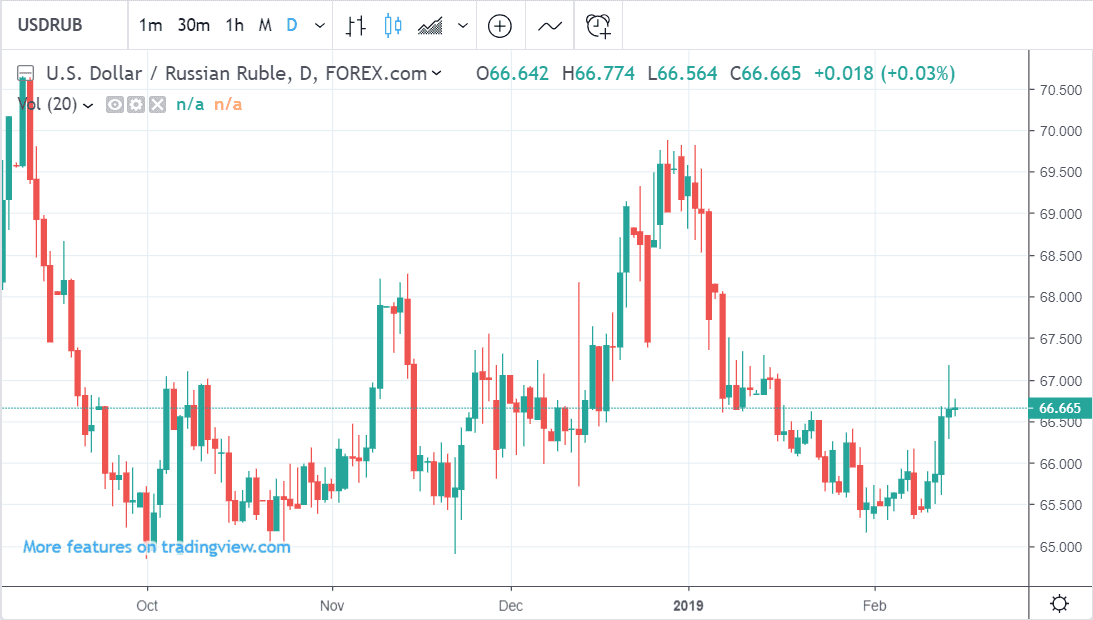Short-term Bullish the Rouble; Mid-term Risks Prevail, Says ING

Image © Adobe Stock
- RUB to rise in short-term on increased bond demand
- Mid-year risks could materialise
- Uncertainty over domestic economy despite strong exports
The Russian Rouble will probably rise in the short-term as strong portfolio inflows into the Russian bond market due to a positive outlook for state finances, along with a generally robust balance of payments supports demand say analysts at ING Bank.
However, there is a risk of disenchantment if sanctions escalate and geopolitical tensions flip the outlook for emerging markets say ING in a recent research briefing on the Rouble.
The Rouble rose 6.1% against the U.S. Dollar in the month of January mainly as a result of increased foreign demand for Russian government bonds says Dmitry Dolgin, chief economist Russia, for ING Bank.
Although the country’s current account surplus was also large, and this is normally a supportive factor for the currency, it was offset by large reserve bank FX buying and capital outflows. The main driver was foreign investor demand for bonds.
“We note that the large capital outflow and FX purchases exceeded the current account surplus but did not prevent RUB's 6.1% appreciation to USD in January, outperforming its peers. This suggests, that the Russian state bond market (OFZ) might have seen foreign portfolio inflows this year after suffering US$9 billion outflows in April-December 2018,” says Dolgin.
The increase in demand for Russian sovereign bonds probably came as a result of Moody’s upgrading Russia’s credit rating from Ba1 to Baa3 on February 8. The upgrade was justified on the basis of an improving fiscal position.
The agency justified the move citing the positive impact of policies enacted in recent years which have boosted the country's public finance and strengthened its economy against external shock, including fresh sanctions.
In the rating agency's view, the impact of likely new sanctions, which is the most likely source of such a shock in the coming months, could be contained without material damage to the country's credit profile.
The country’s current account surplus (its gross exports and capital outflows minus gross imports and capital inflows) is likely to continue to stay high in Q1.
Large FX reserve buying by the Central Bank of Russia (CBR) and high private capital outflows are likely to be an offsetting factor as in January but again demand for Russian bonds (also known as ‘portfolio inflows’) is expected to be the deciding factor.
“We continue to see a US$27-30 billion current account surplus for 1Q19 which, combined with portfolio inflows should be enough to cover the net capital outflow from the private sector and FX purchases, and even with the catch up on the backlog from 2018 are staying within US$4 billion per month. This makes us comfortable with our expectations of USD/RUB at 64-65 for the next 3 months,” says Dolgin.
Midyear could however see risks to the currency increase.
Not only could sanctions start to bite but the U.S. Dollar could also rise if sentiment changes as a result of a more aggressive Federal Reserve changing up from neutral amidst continued strong employment figures. A better trade relationship with China and the rest of the world could also be benign for the U.S. to the detriment of Russia and its rouble.
Another negative factor for the Rouble is the CBR’s habit of letting it currency do the ‘heavy lifting’ during a crisis, according to Simon Derrick, chief currency strategist at BNY Mellon.
“All the indications over the past 12 months are that Russia still intends to use the RUB as a safety valve to protect the economy and local markets from the worst impact of sanctions. Indeed, Economy Minister Maxim Oreshkin said this in April of last year. Moreover, it appears to be working given the performance of the MOEX,” says Derrick.
The CBR used the Rouble as a safety-valve during the crisis in the late 1990s and in 2014, and Derrick thinks the same could happen in 2019.
On Wednesday the U.S. Congress released a whole new set of sanctions against Russia for meddling in U.S. elections and aggression in Ukraine.
Russia will probably use a free-floating RUB as a safety-valve, says Derrick.
“In response, Russia’s finance minister noted that the nation had the tools to shield its economy from possible new sanctions. While he didn’t mention the RUB by name, it definitely is part of the tool kit,” says the BNY Strategist.
Another risk factor for the currency is a possible slowdown in domestic demand despite the strong exports reflected in the current account surplus. This is due to the rise in private capital outflows which suggests domestic investors are seeking opportunities to invest outside of Russia, not seeing the opportunities at home.











